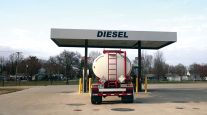Diesel Price Rises 3.9¢
This story appears in the Dec. 9 print edition of Transport Topics.
U.S. retail diesel prices rose for a second straight week, with the national average gaining 3.9 cents to $3.883 a gallon, while gasoline declined, the Department of Energy reported Dec. 2.
The gasoline average price slipped 2.1 cents to $3.272 a gallon, its first decline in three weeks. The motor fuel had risen by almost 10 cents over the previous two weeks.
Diesel, which hadn’t increased since Sept. 2, has risen 6.1 cents over the past two weeks. Last week’s pump price was the highest since Oct. 21.
Trucking’s primary fuel fell by almost 16 cents in the 11 weeks from early September, when it was at a five-month high at just under $4 a gallon.
Diesel is 4.4 cents less than the corresponding week a year ago, while gas is 12.2 cents less than it was a year ago, DOE said after its weekly survey of filling stations.
One Southern California trucking executive said prices have been fluctuating even into last week, according to the carrier’s daily price updates.
“It’s been a yo-yo, up and down all year,” said Dan Hubbard, president of Keeney Truck Lines, a truckload carrier based in Maywood, Calif., near Los Angeles.
To help keep costs in check, Keeney has been using automated manual transmissions since 2007, and they have saved it about a mile per gallon, Hubbard estimated, though its exact savings were difficult to gauge because of its different trailer applications.
“They seem to be helping. They take a lot of thought from drivers’ shift patterns,” he said, adding that “our shippers have been very good about taking on fuel surcharges” with the bouncing prices.
Keeney takes diesel to its on-site fuel tanks, from which it fuels the majority of its 22 tractors, which pull a mix of tankers, dry vans and reefers. Diesel’s wholesale price rose by a nickel on Dec. 3, then slid by a penny the next day, Hubbard said.
California’s on-road diesel average price — which DOE breaks out separately from its five national regions — remained the highest overall price in the country at $4.056 a gallon.
Keeney also has recently begun using “super-single” tires on its 22 tractors to try to save on fuel, Hubbard said.
The state’s mandate that small fleets have side skirts on 50% of their trailers as of Jan. 1 doesn’t make a lot of sense in Southern California, Hubbard said, because the region’s congested freeway speeds average much lower than open-road highways — sometimes as low as 30 mph. The carrier has side skirts in place on its dry vans as required, he said.
Meanwhile, an analyst said diesel has been rising in the past few weeks primarily because of higher demand for distillate fuel as the weather gets colder.
“We’ve seen cold temperatures not only in the U.S., but also in China,” which has been boosting global distillate fuel demand, said Phil Flynn, senior market analyst with the Price Futures Group in Chicago.
An early cold snap around Thanksgiving raised demand for heating oil, which competes with diesel for distillate stock, Flynn said, while a big Arctic cold front moved through much of the Midwest and Plains states last week.
“Refineries retool this time of year to produce more diesel and heating oil, and they are coming out of their maintenance cycles,” Flynn said. “That should help lower prices by the beginning of the year.”
Ongoing high U.S. diesel exports also have helped boost the price, Flynn added. “There’s been strong demand for distillate [fuels] worldwide. I think, overall, that’s a positive for the economy, but it does keep the price up a little.”
After closing at a six-month low of $93.20 a barrel on Nov. 27, oil rose to more than $97 a barrel Dec. 4, the first time it has closed above that level since late October, Bloomberg News reported.
Crude supplies declined for the first time in 11 weeks, while distillate and gasoline supplies rose, DOE said in its weekly inventory report re-leased Dec. 4. Oil inventories fell 5.6 million barrels.
Distillates rose by 2.7 million barrels — putting inventories at about 1.3% below their year-ago level — while gasoline supplies increased by 1.8 million barrels. Analysts had forecast 1.5 million-barrel and 1.3 million-barrel declines for the two fuels, respectively.
TransCanada Corp., meanwhile, said Dec. 3 that it plans to begin operating an oil pipeline from Cushing, Okla., to Gulf Coast refineries.
“That should push up the price of crude a little, but it may lower end-fuel prices after the first of the year,” when refineries can boost output, Flynn told Transport Topics.
DOE reported last week that U.S. refinery capacity rose to 92.4% for the week ended Nov. 29, the highest level since September and almost 9% above the five-year average.




